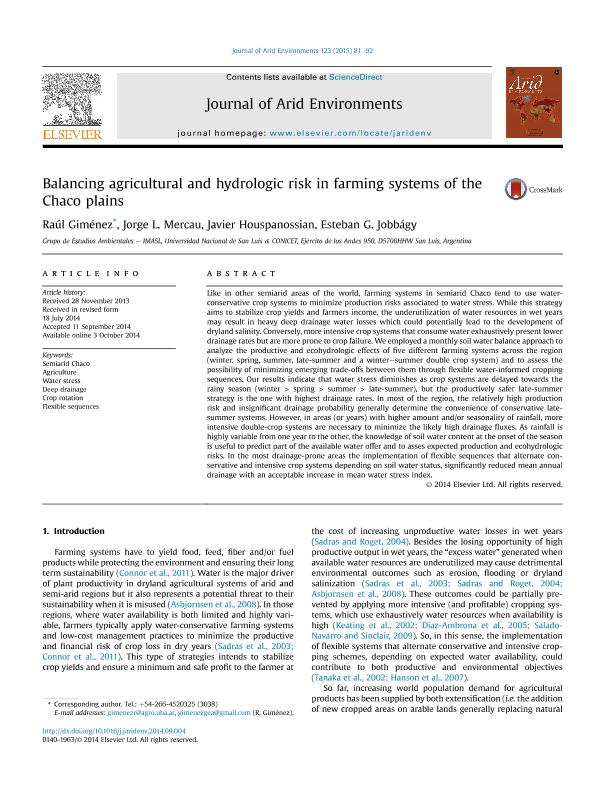Mostrar el registro sencillo del ítem
dc.contributor.author
Giménez, Raúl

dc.contributor.author
Mercau, Jorge L.
dc.contributor.author
Houspanossian, Javier

dc.contributor.author
Jobbagy Gampel, Esteban Gabriel

dc.date.available
2017-03-31T20:12:50Z
dc.date.issued
2015-10
dc.identifier.citation
Giménez, Raúl; Mercau, Jorge L.; Houspanossian, Javier; Jobbagy Gampel, Esteban Gabriel; Balancing agricultural and hydrologic risk in farming systems of the Chaco plains; Elsevier; Journal Of Arid Environments; 123; 10-2015; 81-92
dc.identifier.issn
0140-1963
dc.identifier.uri
http://hdl.handle.net/11336/14639
dc.description.abstract
Like in other semiarid areas of the world, farming systems in semiarid Chaco tend to use water-conservative crop systems to minimize production risks associated to water stress. While this strategy aims to stabilize crop yields and farmers income, the underutilization of water resources in wet years may result in heavy deep drainage water losses which could potentially lead to the development of dryland salinity. Conversely, more intensive crop systems that consume water exhaustively present lower drainage rates but are more prone to crop failure. We employed a monthly soil water balance approach to analyze the productive and ecohydrologic effects of five different farming systems across the region (winter, spring, summer, late-summer and a winter?summer double crop system) and to assess the possibility of minimizing emerging trade-offs between them through flexible water-informed cropping sequences. Our results indicate that water stress diminishes as crop systems are delayed towards the rainy season (winter > spring > summer > late-summer), but the productively safer late-summer strategy is the one with highest drainage rates. In most of the region, the relatively high production risk and insignificant drainage probability generally determine the convenience of conservative late-summer systems. However, in areas (or years) with higher amount and/or seasonality of rainfall, more intensive double-crop systems are necessary to minimize the likely high drainage fluxes. As rainfall is highly variable from one year to the other, the knowledge of soil water content at the onset of the season is useful to predict part of the available water offer and to asses expected production and ecohydrologic risks. In the most drainage-prone areas the implementation of flexible sequences that alternate conservative and intensive crop systems depending on soil water status, significantly reduced mean annual drainage with an acceptable increase in mean water stress index.
dc.format
application/pdf
dc.language.iso
eng
dc.publisher
Elsevier

dc.rights
info:eu-repo/semantics/openAccess
dc.rights.uri
https://creativecommons.org/licenses/by-nc-nd/2.5/ar/
dc.subject
Semiarid Chaco
dc.subject
Agriculture
dc.subject
Water Stress
dc.subject
Deep Drainage
dc.subject.classification
Oceanografía, Hidrología, Recursos Hídricos

dc.subject.classification
Ciencias de la Tierra y relacionadas con el Medio Ambiente

dc.subject.classification
CIENCIAS NATURALES Y EXACTAS

dc.title
Balancing agricultural and hydrologic risk in farming systems of the Chaco plains
dc.type
info:eu-repo/semantics/article
dc.type
info:ar-repo/semantics/artículo
dc.type
info:eu-repo/semantics/publishedVersion
dc.date.updated
2017-03-31T18:13:39Z
dc.journal.number
123
dc.journal.pagination
81-92
dc.journal.pais
Países Bajos

dc.journal.ciudad
Amsterdam
dc.description.fil
Fil: Giménez, Raúl. Consejo Nacional de Investigaciones Científicas y Técnicas. Centro Científico Tecnológico San Luis. Instituto de Matemática Aplicada de San Luis; Argentina. Universidad Nacional de San Luis; Argentina
dc.description.fil
Fil: Mercau, Jorge L.. Consejo Nacional de Investigaciones Científicas y Técnicas. Centro Científico Tecnológico San Luis. Instituto de Matemática Aplicada de San Luis; Argentina. Universidad Nacional de San Luis; Argentina
dc.description.fil
Fil: Houspanossian, Javier. Consejo Nacional de Investigaciones Científicas y Técnicas. Centro Científico Tecnológico San Luis. Instituto de Matemática Aplicada de San Luis; Argentina. Universidad Nacional de San Luis; Argentina
dc.description.fil
Fil: Jobbagy Gampel, Esteban Gabriel. Consejo Nacional de Investigaciones Científicas y Técnicas. Centro Científico Tecnológico San Luis. Instituto de Matemática Aplicada de San Luis; Argentina. Universidad Nacional de San Luis; Argentina
dc.journal.title
Journal Of Arid Environments

dc.relation.alternativeid
info:eu-repo/semantics/altIdentifier/url/http://www.sciencedirect.com/science/article/pii/S0140196314001888
dc.relation.alternativeid
info:eu-repo/semantics/altIdentifier/doi/http://dx.doi.org/10.1016/j.jaridenv.2014.09.004
Archivos asociados
